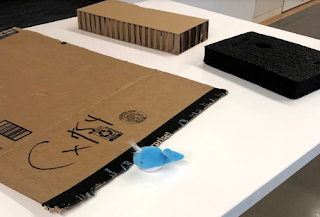The first graders do a big design and building project that starts early in the school year. This project is long and incorporates lots of parts including the students make a working art robot. This is a collaborative project with the library, technology and the classroom teachers. At the end of the project each year, all the teachers involved in the project get together and reflect on what worked and what did not work with the project and any ideas to change things for the following year. This is a way that I “partner with other educators to scaffold learning and organize learner groups to broaden and deepen understanding” (School Library III.A.1). One of the suggestions from the first grade team was the students do a short building project before the bigger design project. The idea was this would help remind students where materials are in the makerspace. It would also get students back into the mindset of using different materials, working to build with others and then cleaning up the makerspace. We wanted this one session build to get students thinking about building and collaboration. The great book “Made By Maxine” by Ruth Spiro and Illustrated by Holly Haatam was the inspiration for the project.
We started by reading the book. In the story Maxine is a maker. She makes new things out of old things, tinkers and builds. She meets Milton, the goldfish and he is the best pet in the world. Maxine builds him amazing fish tank with different spaces and rooms using different materials. She also makes Milton an automatic feeding machine and a musical sensor machine! When it is time for the school pet parade, Maxine is determined to invent a way for Milton to be able to take part. She tinkers and builds but nothing works. She is about to give up but realizes that Milton is her friend and she wants him to come to the parade, Maxine goes back to the drawing board and makes, tinkers, builds and rebuilds, designs and redesigns and she makes Milton an amazing mobile, musical fish tank float for the school parade.
After reading the book, students talked about what happened in the beginning, middle and end of the story. They also talked about challenges Maxine faced as she was trying to make a float for Milton to be in the parade. Students discussed how she failed several times before she was able to come up with a plan that worked for Milton.
The next step was for students to engage in a rapid prototype challenge inspired by the book. We set out a random set of materials; cardboard, foam, empty tape rolls, etc, for each group. Then we had a collection of tape, scissors, pipe cleaners, straws and streamers. Finally, each group had a small toy animal on their table. The challenge was for students to build only using the materials on their table and the items in the bins.
When students arrived for class, I explained the challenge. Just like Maxine made something for Milton, they would need to make something for their animal. This was a way to have students think about what they learned for the story and make and create something new. This “allowed learners to build on their prior knowledge and create new knowledge” (School Librarian III.B.2). Each group would work with only the materials at their table and the options in the bins. They would need to rapidly design and prototype something the would benefit their animal. The students had four minutes to look at their materials, talk with their partners and plan. This was a way that learners “actively contributed to group discussions” (Learner III.D.1). Then they had fifteen minutes to build. The last five minutes each group explained what they built and how it would benefit their animal.
Students were creative with their designs. They built spaces for the elephant to find shade and water on hot days, an obstacle course for the alligator so they would have things to do, small and large pools for the whale to swim around, and more. Students talked with each and designed together, including ideas from each member of the group and because of the time limit really worked together to complete the challenge. This was a way to help learners “recognize learning as a social responsibility” (Learner III.D.2).
The goal of this project was for students to start thinking about how to plan and design together and how to use different materials. We will be diving into the larger Dot Day project that will involve more research and planning, as well as many options for students to use to build their robots. This rapid prototype lesson was a way to help get them into the collaboration, tinkering and designing mindset.






No comments:
Post a Comment
Note: Only a member of this blog may post a comment.